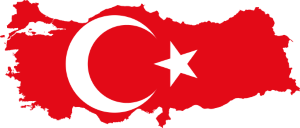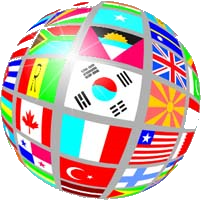Turkey -- School-age
Turkey
Official Name: Republic of Turkey
Government Type: Parliamentary constitutional republic with an executive presidential system
Capital: Ankara
County's inhabitants: Turk(s)
Abbreviation: TR
Currency: Turkish Lira ![]() (TL) (TRY)
(TL) (TRY)
Official Language: Turkish
Kurdish, other minority languages.
Religion: Muslim 99.8% (mostly Sunni), other 0.2% (mostly Christians and Jews)
Turkey is officially a secular state.
Population: Turkish 70-75%, Kurdish 19%, other minorities 7-12% (2016 est.)
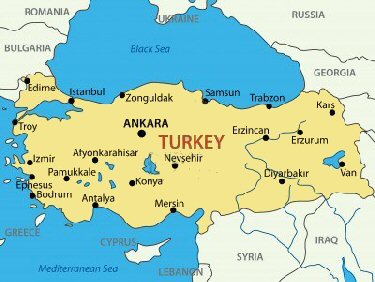
Turkey is located on the continents of Europe and Asia. It is a transcontinental country bridging Southeastern Europe and Southwestern Asia.
97% of Turkey is in Asia and this part is called Anatolia or Asia Minor; 3% is in Europe which is called Thrace. Although 97% of Turkey is located in Asia, in many respects it is accepted as a European country. Turkey takes its place in nearly all European country associations.
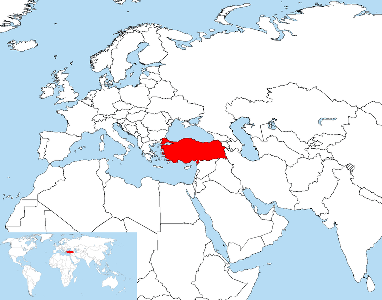
History
The Asian part of Turkey is called Anatolia. Located in south-central Turkey, Catal Huyuk was one of the world’s first towns. It was inhabited 9000 years ago and was a labyrinth of mud homes joined together. There were no streets and people entered the homes through holes in the roof.
Due to Turkey's location at the intersection of Asia and Europe, it has been a place of several civilizations. The Hitties about 4,000 years ago ruled for hundreds of years. The Trojan War between the Greeks and the people of Troy. Troy is believed to be an ancient city located at Hisarlik in present-day Turkey.
King Midas was a real person that ruled western Turkey around 700 BC In 334 BC. Listen to King Midas and the golden touch
The Persian Empire would expanded into Anatolia. The Greeks and Persians fought over the land. Alexander the Great would rule Anatolia until the Romans took over and Anatolia became part of Roman Asia Minor.
Catal Huyuk Video
The Roman Emperor Constantine I would build his new capital called New Rome on the site of the ancient city of Byzantium. It was renamed Constantinople after whom it was renamed in 330 AD. The Roman Empire would break into two parts the Roman Empire (west) and the Byzantine Empire (East). The Byzantine Empires capital was Constantinople (today Istanbul).
In 1453, the Ottomans would conquer Turkey and it would become part of the Ottoman Empire. The Ottoman Empire would collapse at the end of World War I in 1918. After World War I Greece would invade Turkey which led to the Greco-Turkish War, 1919-22. At the head of the army was Turkish army officer Mustafa Kemal Atatürk. A peace treaty was signed in July 1923. Mustafa Kemal Atatürk would become Turkey's first president.
History of Turkey Video
Government
Turkey is a constitutional republic, a type of government in which government officials are elected by the people and must govern according to the laws of the constitution, and its actions are subject to judicial review.
The 1961 constitution was replaced in 1982 after the 1980 military coup in which the country was governed by the National Security Council, a five-member body of military officers. The new constitution proclaimed Turkey's system of government as democratic, parliamentary, and secular.
Turkey's parliamentary form of government, consisted of a president as the head of state which was mostly a ceremonial position, a prime minister is the head of government and is in charge of the country, the Cabinet, and a legislature, the National Assembly. The National Assembly is elected by the people for a 5-year term.
A failed coup attempt in Turkey in 2016 led to significant political changes. A presidential system was adopted by referendum in 2017. The constitutional amendments approved in the 2017 constitutional referendum abolished the office of Prime Minister, and gave the presidency with full executive powers.
The president is the head of state and the head of government. The president has complete control of the executive branch, is the commander-in-chief of the Turkish military, and also heads the National Security Council.
Flag of Turkey
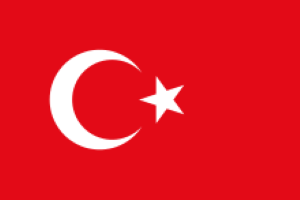
The flag of Turkey is a red background with a white crescent and five-pointed star slightly to the left of center.
Many myths are associated with the meaning of the red color and the star and crescent on Turkey's flag. A crescent has been on the flag since the 16th century. It was a symbol of the goddess Diana, a guardian of the city of Byzantium (today Istanbul). The star originally was an eight-pointed star that is associated with the Virgin Mary when Emperor Constantine I made Christianity the official faith of the Roman Empire.
The crescent and star became associated with Islam after the Ottomans captured the Anatolian peninsula and added the crescent and star to their own plain red flags. In the 1800s, the star was changed to a five-pointed star. The flag of Turkey that is used today became the national banner in 1936.
Land
Aegean Region
The Aegean region consists mainly of rolling plateau country well suited to agriculture with olive groves, rocky crags and pine woods. The Aegean region has a mild climate of wet winters and hot, dry summers. Izmir is the gateway to the Aegean region.
Mediterranean Region
The narrow coastal plains of the Mediterranean region is separated from Anatolia by the Taurus Mountains. Fertile soils and a warm climate make the area ideal for growing citrus fruits, grapes, figs, bananas, various vegetables, barley, wheat, and, in irrigated areas, rice and cotton.
Anatolian Plateau
Stretching inland from the Aegean coastal plain, the plateau-like, semiarid highlands of Anatolia are considered the heartland of the country. The central Anatolian plateau experiences the harshest climates due to mountain ranges with hot summers and cold snowy winters.
Central Anatolian Region Tuz Gölü (Salt Lake) was the second largest lake in Turkey. Today it is the size of a puddle due to droughts.
Derinkuyu Underground City - The underground cities have about 8 stories dug into the earth.
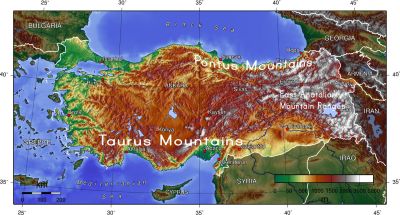
Pontus and Taurus Mountains
The Pontus Mountains in the north are an interrupted chain of folded highlands that generally parallel the Black Sea coast. The southern slopes--facing the Anatolian Plateau--are mostly unwooded, but the northern slopes contain dense growths of both deciduous and evergreen trees. The Taurus Mountains in southern Turkey are the westernmost branch of the great mountain chain that stretches across all of Asia -- the Himalayan mountain belt.
Eastern Highlands
Eastern Anatolia, where the Pontus and Taurus mountain ranges converge, is rugged country with high elevations and a severe climate (severe winters with heavy snowfalls). The region is known as the Anti-Taurus. Mount Ararat, at 5,166 meters is the highest mountain in Turkey, is located in the Anti-Taurus.
Turkey's largest lake, Lake Van, is situated in the mountains at an elevation of 1,546 meters. Lake Van originated in 1441 from the explosion of the Nemrut volcano.
Most of eastern Anatolia comprises the area known historically as Kurdistan.
Arabian Platform
The Arabian Platform is in southeast Anatolia south of the Anti-Taurus Mountains. It is a region of rolling hills and a broad plateau surface that extends into Syria
Earthquakes
Turkey is one of the most earthquake-prone areas.
Turkey is a country located at a point where the 3 continents of the old world (Asia, Africa and Europe) are closest to each other and where Asia and Europe meet.
Turkey is located on the Anatolian tectonic plate. The Anatolian plate is between two major plates, the Eurasian plate (the immovable object) and the Africa/Arabia plate.
The Anatolian plate is moving easterly. The African/Arabian plate is moving nothwest. Eurasian plate not moving - the immovable object.
Turkey is being squeezed westwards towards the Aegean sea. The most destructive earthquakes have been caused by movement along the North Anatolian fault were the Anatolian and Eurasian plates meet..
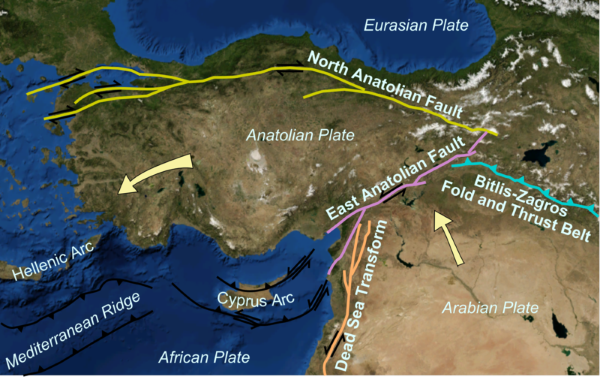
Animals
You are likely to see cattle, horses, donkeys, goats and sheep throughout Turkey. Turkish shepherds are proud of their Kangal sheep dogs which guard the flocks from .
.Bird life is exceptionally rich with eagles, vultures and storks, as well as rare species such as the bald ibis.
The beautiful Van cat is a native of Turkey. It has pure white fur and blue or amber eyes, or different-colored eyes - one blue, one green.
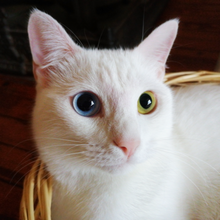
The Turkish Angora Cat is one of the most ancient and purest long haired cat breeds ever discovered.
The Denizli rooster has been raised in Denizli since ancient times.
The Caretta-Caretta is a Mediterranean Sea turtle that has been added to the protected species list.
There are no native camels in Turkey, but there is camel wrestling.
Plants
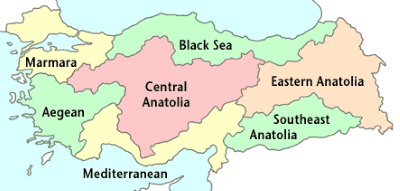
Turkey Regions
Turkey has a variety of weather climates and environments.
The flora of Turkey is divided into three areas; these are the Euro-Siberian flora area, the Mediterranean flora area; and the Irano-Tranian flora area.
The Mediterranean flora area includes Western Anatolia: includes Thrace, southern part of Marmara Region and Aegean Region. It also includes the Taurus Mountains, and the Amanos Mountains. In this area are forest of oaks, pines, fir, spruce, and Mediterranean vegetation.
The Euro-Siberian flora area includes the Black Sea Region and some of Marmara Region. A mountainous part of Turkey with forests of oak and pine. There are grasslands, steppes (a large area of flat unforested grassland), shrubland, and mountain forest.
The Irano-Tranian flora area is the rest of the country.
Turkey Is Famous For
Hagia Sophia
The Hagia Sophia was built during the Byzantine Empire. The Hagia Sophia began as a church. Later it was made into a mosque. From 1935 to 2020 it was a museum. In 2020 it was reopened a mosque under the government of President Erdogan.
Turkish Rugs
Rug weaving dates back centuries. Turkish rugs are an art form of colors and designs. The designs are made up of geometric patterns surrounded by a border. Turkish rugs were used as wall, door, and floor coverings. The rugs were also used as prayer mats.
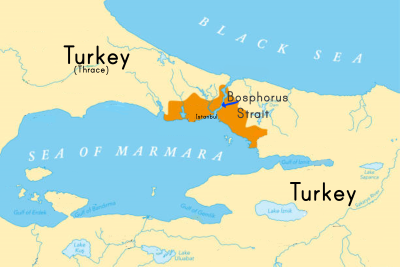
The Bosphorus Strait
The Bosphorus Strait is part of the boundary between Europe and Asia. It is an important waterway in the region. It is a natural strait connecting the Black Sea to the Sea of Marmara. It then flows to the Aegean and Mediterranean Sea via the Dardanelles, it connects to the Atlantic Ocean through the Strait of Gibraltar, and the Indian Ocean through the Suez Canal.
Turkey Products
Turkey is the world's largest producer of hazelnuts. Turkey is responsible for 70% to 80% of the worlds hazelnut production. Turkey exports hazelnuts to more than 100 countries.
Cars are the leading export of Turkey. Turkey's other top export products are automotive parts, trucks, refined petroleum and jewelry.
Weave A Friendahip Bracelet Video

